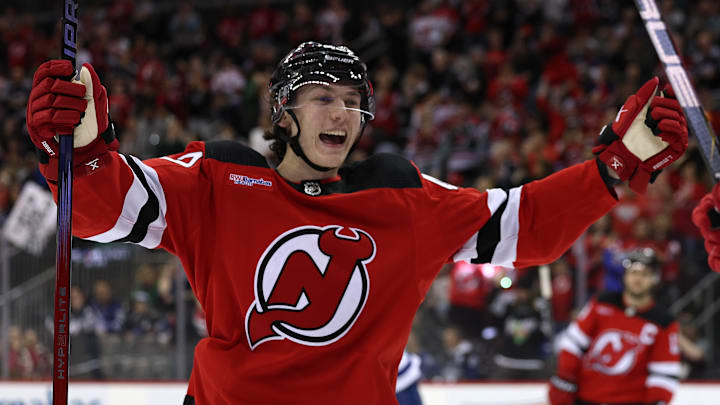One of Tom Fitzgerald’s top priorities in the coming year should be signing Luke Hughes to an eight-year extension that cements him as part of the long-term core of a Cup-contending New Jersey Devils team. Hughes is eligible to sign an extension on July 1st, with one year remaining on his entry-level contract.
But can the Devils really afford to pay Luke Hughes more than his brother Jack Hughes’s $8 million average annual value (AAV)?
The same arguments were trotted out this time last year when the Devils entered negotiations on long-term extensions with pending restricted free agents Jesper Bratt and Timo Meier. The argument boiled down to its simplest form: if Jack Hughes is the team's best player and he’s only making $8 million, how can anyone on the roster be paid more?
It was a farce last year, and it’s even more of a farce now, as the league’s salary cap is set to rise from $83.5 million to $87.7 million. The Devils took a risk when they signed Jack Hughes, coming off a serious injury, to an eight-year, $64 million extension. But that risk has paid off beautifully as the deal has become one of the league’s best.
But it doesn’t mean that the Devils can arbitrarily lock all their best players in under Jack’s annual rate. It didn’t work last year, as Timo Meier signed a contract with a cap hit of $8.8 million, and it won’t work in the negotiations with Luke Hughes either.
Devils fans should prepare for the sticker shock in advance. The extension Luke Hughes signs with the Devils will, at minimum, start with a 9. As in, more than $9 million.
Looking at recent contract comparables, it’s easy to see why Luke is about to increase his salary tenfold. Top NHL Draft pick defensemen coming off their entry-level contract frequently break the bank of their teams upon signing their second contract.
Let’s start with two easy comparison points: the Ottawa Senators’ Jake Sanderson, who was picked fifth overall in the 2020 Draft, and the Buffalo Sabres’ Owen Power, who was picked first overall in the 2021 Draft where Luke was drafted fourth overall.
Sanderson signed his extension in September before the 2023 season for $8.05 million. Power signed his extension a month later for $8.35 million. Power’s contract made up 10% of the salary cap at the time of signing. A comparable percentage of this year’s cap for Luke Hughes puts him at $8.77 million AAV in 2024-2025 dollars.
But the Hughes contract wouldn’t kick in until 2025-2026. Assuming the cap projections reported by Elliotte Friedman are accurate, the NHL’s salary cap in 2025-2026 is projected to be just under $93 million.
Elliotte Friedman reports that the NHL salary cap will increase to “just under $93 million” for the 2025-2026 season. https://t.co/yflbskFzKX
— /r/Habs (@HabsOnReddit) June 25, 2024
That would put a Luke Hughes contract comparable to Owen Power’s at $9.3 million against the cap.
Hughes has arguably been better than Power and Sanderson despite a shorter track record than both, so you could make the case that he deserves even more than that $9.3 million figure. Any significant amount more than that will have people start questioning whether the Devils would be better off with him on a bridge deal until he proves that he is worth paying as a #1 defender.
Buyer beware in that case, as highly lauded defenders coming off bridge deals tend to get even larger contracts than those that sign long-term right away. Buffalo just gave Rasmus Dahlin 11 million a season, while Zach Werenski signed for 9.58 million a few seasons ago.
The comparables above also assume that no other defender contracts set a new standard for the market before Hughes signs his extension. Each subsequent RFA signing brings with it the risk that the price on Hughes increase. Moritz Seider, an RFA for Detroit, will likely get a raise this summer on what Power and Sanderson got a season ago.
And there is another elephant in the room here: Everything about Luke Hughes’ extension price is also true of Simon Nemec. The only differences between them are that Nemec was drafted two spots higher in the draft than Hughes, that he is not eligible to sign an extension for another year, and that extension wouldn’t kick in until the 2026-2027 season.
There is a price to be paid for having great young talent in an NHL where the salary cap is set to rise for the first time in years. How the Devils manuever around the rising cost of their superstar defenders could make the difference in building a winning roster.
